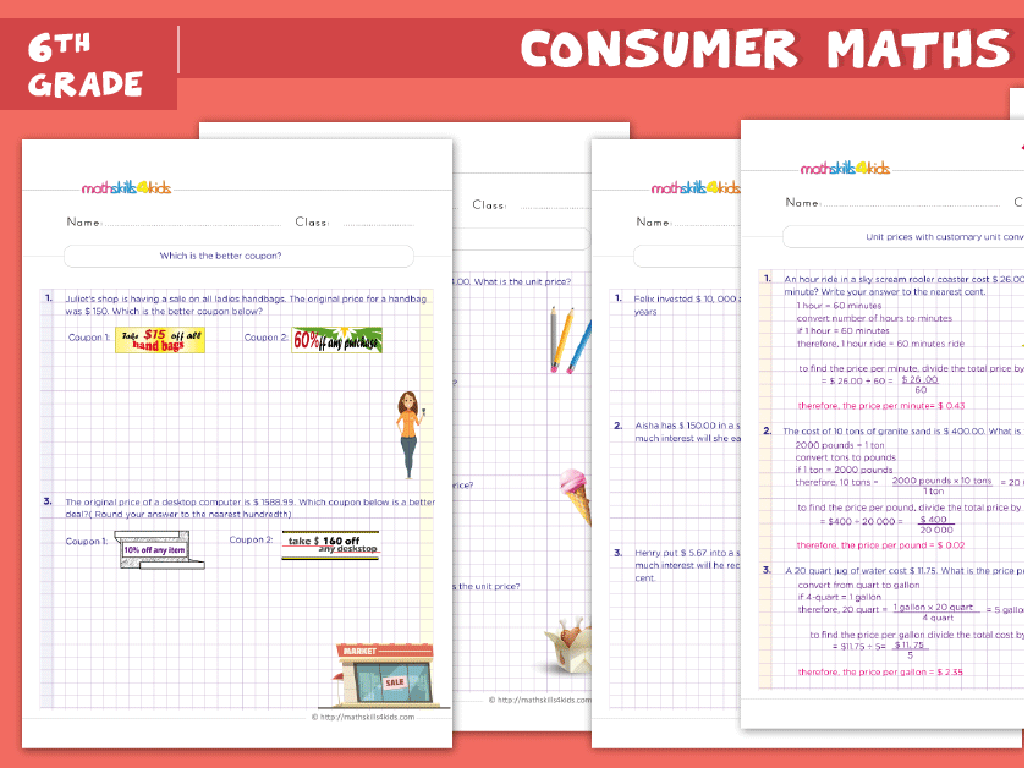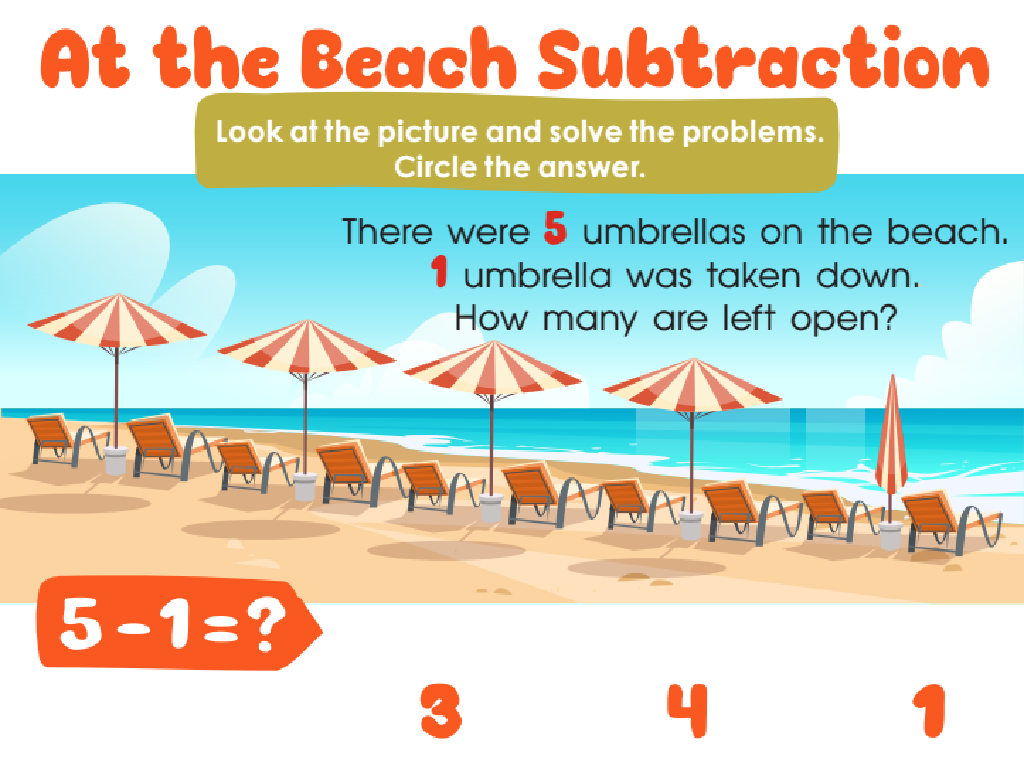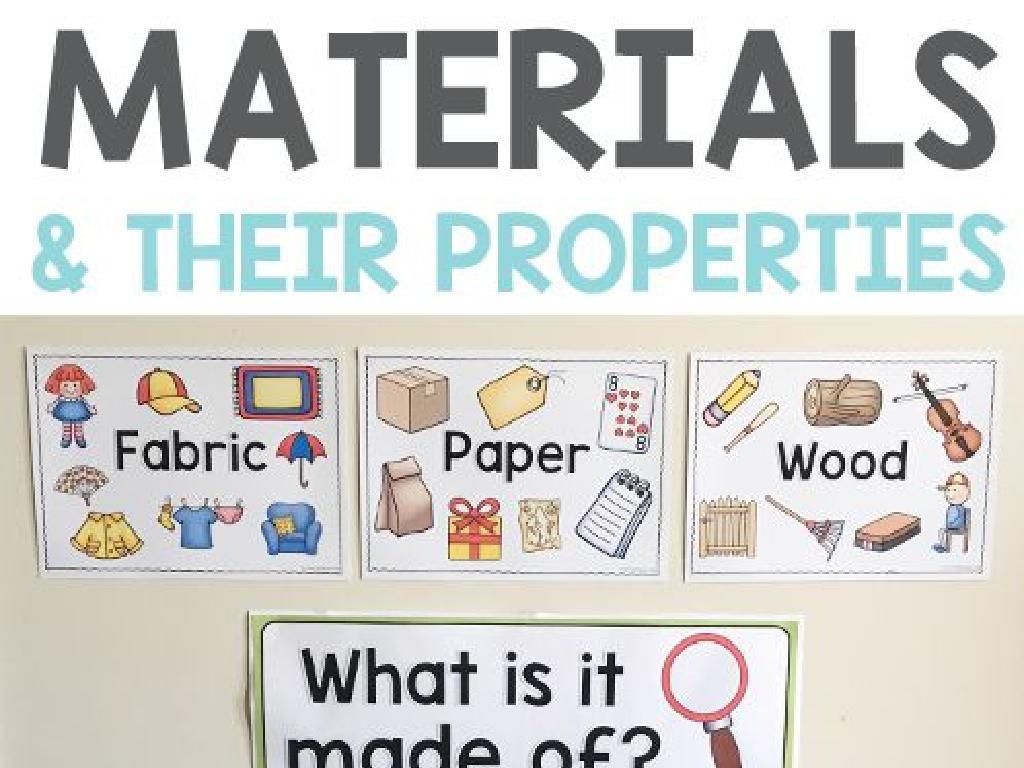Make Halves
Subject: Math
Grade: Second grade
Topic: Fractions
Please LOG IN to download the presentation. Access is available to registered users only.
View More Content
Welcome to Fractions: Making Halves!
– Learning to make halves
– Splitting into equal parts
– Dividing something into 2 equal pieces
– What does ‘half’ mean?
– ‘Half’ means one of two equal parts of a whole
– Examples of halves
– Like cutting an apple into 2 equal slices
|
This slide introduces the concept of halves as a fundamental part of understanding fractions. Start by explaining that making halves means dividing something into two equal parts. Emphasize that each part must be exactly the same size to be considered a half. Use tangible examples, such as cutting an apple or sharing a sandwich, to illustrate the idea of halves. Encourage students to think of other items they could split into halves. This will help them grasp the concept of ‘half’ as it applies to everyday situations and lay the groundwork for more complex fraction concepts.
Understanding Fractions: Making Halves
– What is a fraction?
– A fraction represents a part of a whole item or group.
– A cookie can show fractions
– Imagine breaking a cookie into pieces; each piece is a fraction.
– Each piece is part of the whole
– When you take one piece, it’s a fraction of the entire cookie.
– Halves make two equal parts
– Splitting something into two equal parts creates halves.
|
Begin by explaining that a fraction represents a part of a whole, using simple and relatable terms for second graders. Use the example of a cookie to illustrate the concept visually and tangibly. Explain that when a cookie is broken into smaller pieces, each piece is a fraction of the original cookie. Emphasize that when we make halves, we are dividing something into two equal parts, and each part is called a half. This will set the foundation for understanding that fractions are a way to represent equal parts of a whole. Encourage students to think of other examples of halves in their daily lives.
Understanding Halves
– What is a half?
– A half means one of two equal pieces of a whole.
– Dividing into 2 equal parts
– Imagine cutting an apple into two same-size pieces.
– Each part is one of the halves
– If you take one piece, you have a half, or 1 out of 2.
– Writing half as a fraction
– The fraction 1/2 represents one half.
|
This slide introduces the concept of halves in the context of fractions. Begin by explaining that a half results from dividing something into two equal parts. Use tangible examples like cutting an apple or sharing a pizza to illustrate the idea. Emphasize that each part is one of the two equal parts, and this is what we call a half. Show how this is represented in fraction form as 1/2. Use visual aids like drawings or physical objects to help students visualize the concept. Encourage students to think of other examples of halves in their daily lives.
Understanding Halves in Everyday Life
– What are halves?
– Halves mean dividing something into 2 equal parts.
– Cutting an apple into two parts
– When you cut an apple evenly, you make 2 halves.
– Sharing a sandwich equally
– If you split a sandwich into 2 equal pieces, each is a half.
– Halves in daily activities
|
This slide is aimed at helping second-grade students recognize and understand the concept of halves through relatable examples. Begin by explaining that a half is one of two equal parts of a whole. Use visuals like an apple cut into two equal parts to show this division clearly. Discuss how sharing food like a sandwich can be an example of halves, and encourage students to think of other examples from their daily lives where they encounter halves. The goal is to make the concept of halves tangible and easy to grasp by connecting it to familiar objects and situations.
Making Halves in Fractions
– What are halves?
– Halves are two equal parts of a whole.
– Dividing with a line
– Draw a straight line to split an object into two parts.
– Equal parts are essential
– Both parts must be identical in size.
– Practice making halves
– Let’s cut shapes and objects into halves.
|
This slide introduces the concept of making halves, which is a fundamental part of understanding fractions. Start by explaining that a half is one of two equal parts of a whole. Use visual aids to show how drawing a line through the center of an object can divide it into halves. Emphasize that for two parts to be considered halves, they must be exactly the same size. Encourage students to practice by cutting out paper shapes or using objects like fruits to visually see and understand the concept of halves. Provide several examples and hands-on activities to reinforce the lesson.
Let’s Practice Making Halves!
– Now it’s your turn to try!
– Draw lines on shapes to make halves
– Use a ruler to draw a straight line
– Both sides must be equal
– Each half should look the same size
|
This slide is designed for a class activity where students will practice the concept of making halves. Provide students with various shapes such as circles, squares, and rectangles. Encourage them to use a ruler to draw a straight line through the shapes to divide them into two equal parts. Emphasize that for a shape to be halved correctly, both sides must be of equal size and shape. As an extension, you can ask students to color one half to visually reinforce the concept of equality. Possible activities include cutting out paper shapes and folding them to find the line of symmetry, using playdough to create shapes and slice them into halves, or drawing shapes on the board for students to come up and divide. This hands-on experience will help solidify their understanding of halves and fractions.
Class Activity: Making Halves
– Activity: Create Your Own Halves
– Materials needed: Paper, scissors, coloring materials
– Step 1: Color your paper
– Use your favorite colors to decorate
– Step 2: Fold and cut to make halves
– Make sure both halves are equal in size
|
This hands-on activity is designed to help second-grade students understand the concept of halves by creating them physically. Provide each student with a sheet of paper, scissors, and coloring materials. Guide them to color the entire paper first, using this as an opportunity to express creativity. Next, demonstrate how to fold the paper in half evenly, ensuring that the edges meet perfectly. Show them how to cut along the fold carefully to produce two equal halves. Emphasize the importance of precision to ensure both pieces are the same size, reinforcing the concept of halves. As an extension, students can compare their halves with a partner to see if they are indeed equal, or even try folding and cutting different shapes in half.
Review: Understanding Halves
– Recap: What are halves?
– Identify halves in daily life
– Think of fruits, toys, or sandwiches cut into two equal parts
– Open floor for questions
– Encourage curiosity and exploration
– There are no silly questions, every query is important!
|
This slide aims to consolidate the students’ understanding of the concept of halves that was taught in today’s lesson. Start by asking the students to recall what they have learned about halves. Encourage them to think of examples from their daily lives where things can be divided into two equal parts, such as cutting an apple or sharing a cookie with a friend. This real-world connection helps solidify their understanding. Open the floor for any questions the students might have, reassuring them that all questions are valid and important for learning. This is also a chance to assess their grasp of the concept and to address any misconceptions. Finally, foster a sense of curiosity and encourage them to explore the concept of halves further, both in the classroom and at home.
Fantastic Halves: Conclusion
– Congratulations on learning halves!
– Understanding equal parts is key
– Halves are two equal parts of a whole
– Practice making halves at home
– Try cutting fruits, or folding paper
– Use everyday items for practice
– Toys, like building blocks, work too!
|
This slide wraps up the lesson on making halves, reinforcing the concept of dividing objects into two equal parts. It’s important to celebrate the students’ understanding and encourage them to apply this knowledge in their daily lives. Suggest that they practice by dividing various items at home, such as slicing a banana or an apple into two equal parts, folding sheets of paper to create symmetrical halves, or evenly splitting a set of toys between themselves and a friend. These activities will help solidify their grasp of the concept of halves and demonstrate the practical application of fractions in a fun and engaging way.



-satisfy-an-equation/basic_two_variable_equations.png)


